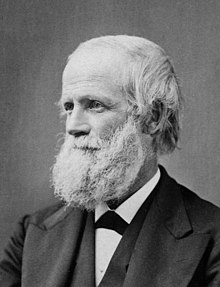Benjamin Franklin Mudge
Benjamin Franklin Mudge (born August 11, 1817 in Orrington , Massachusetts , † November 21, 1879 in Manhattan , Kansas ) was an American lawyer, geologist, paleontologist and teacher. He was one of the most successful dinosaur hunters and fossil collectors in the United States in the 19th century.
Life
Born in what is now Maine , Benjamin Mudge came from a Methodist family and moved with his family to Lynn , Massachusetts, where he grew up in 1818 . As a young man, he worked as a shoemaker for six years to support his family before studying science and classical languages at Wesleyan University, graduating in 1840. He later received the title of Master of Arts there . He went on to study law and was admitted to the bar in 1842. In the same year he married. In 1852 he was elected mayor of Lynn. In 1859 he moved to Kentucky , where he worked as a chemist for an oil company, and in 1861 to Kansas, where he worked as a teacher. During the civil war , he moved to Quindaro , an abolitionist stronghold , to demonstrate his anti-slavery attitude. He gave lectures on geology and its economic importance in 1864, which prompted the Kansas Legislature in Topeka to set up a geological survey (Geological Survey) and Mudge became the first state geologist of Kansas. Despite a tight budget, he was able to deliver a first report in the same year that focused on stratigraphy and mineral resources (coal, salt). A more complete report was produced by Swallow the following year; thereafter the land survey was suspended until the Kansas Geological Survey was founded in 1895 . In 1865 Mudge became a professor of science at the Kansas State Agricultural College (KSAC), later the University of Kansas . In 1873 he gave up the professorship after a dispute over pay. He then excavated full-time for Othniel Charles Marsh , working with Marsh's assistant, Samuel Wendell Williston .
He began systematically collecting fossils in Kansas in 1865. One of his best-known finds is the find of Diplodocus (whose bones had already been found there by Oramel Lucas), which he excavated in Garden Park near Cañon City in Colorado with Williston in 1877 and that of Marsh was described. The first dinosaurs were discovered there in 1876, after which, as part of the Bone Wars between Edward Drinker Cope and Marsh, Cope first had Cope dig there and in 1877 Marsh, who sent Mudge and Williston there. In 1877 Mudge found the holotype of Allosaurus with Williston in Garden Park . The finds from Garden Park in 1877 were poorly preserved and Marsh ordered Mudge back to the rich site of Como Bluff in the Wyoming Territory soon afterwards . In 1872 he discovered the holotype of Ichthyornis and sent it to Marsh as the first bird fossil with teeth (in the London Archeopteryx they had previously been overlooked by Richard Owen ). In 1875 he published the first geological map of Kansas.
Most of the finds he sent to paleontologists on the east coast, who also described them, and many of his finds can be found in the great museums of the east coast such as the Smithsonian and Peabody museums. Scientists he has had contacts with include Marsh (Peabody Museum) and his major competitor Cope (Philadelphia), Louis Agassiz (Harvard), James Dwight Dana (Yale), Leo Lesquereux as a botanist, and Fielding Bradford Meek , an expert on Mollusks .
In 1867 he founded the Kansas Natural History Society with John D. Parker and became its president. In 1878 he became a Fellow of the American Association for the Advancement of Science .
Fonts
- First Annual Report of the Geology of Kansas, Lawrence, Kansas, 1866, Archives
Web links
- Benjamin Franklin Mudge in the database of Find a Grave (English)
- Mike Everhart biography
- Biography, Robinson Library
- Kansas Historical Society
Individual evidence
- ^ Dinosaur Depot Museum, A Short History of Dinosaur Collecting Garden Park Fossil Area, Cañon City, Colorado
| personal data | |
|---|---|
| SURNAME | Mudge, Benjamin Franklin |
| BRIEF DESCRIPTION | American lawyer, geologist, paleontologist, and teacher |
| DATE OF BIRTH | August 11, 1817 |
| PLACE OF BIRTH | Orrington , Massachusetts |
| DATE OF DEATH | November 21, 1879 |
| Place of death | Manhattan , Kansas |
